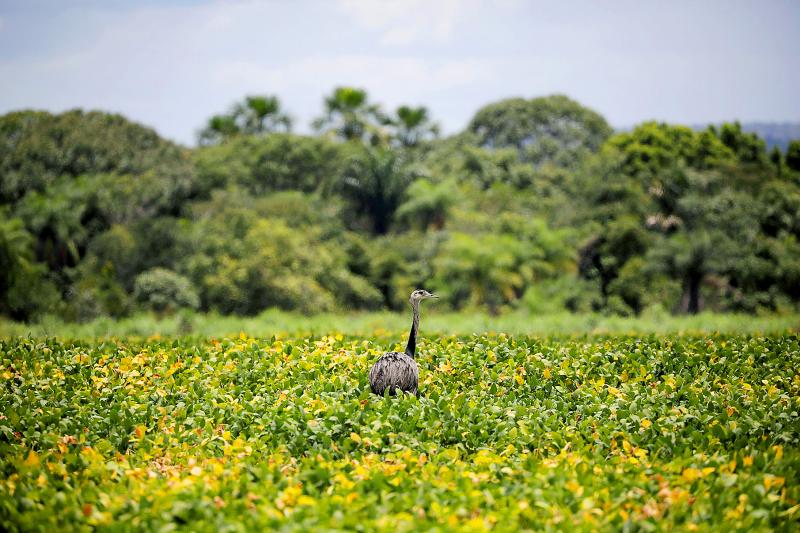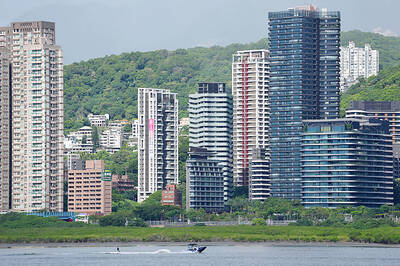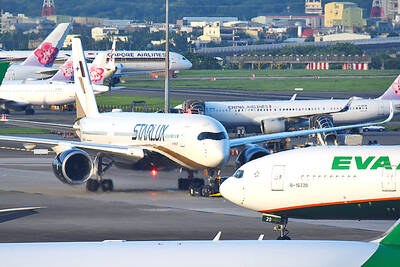More bad weather for the world’s oilseed growers is pushing rapeseed and canola prices to fresh records and adding to food inflation worries.
Futures have been on a tear for a while, after last year’s harvests in Canada and Europe were plagued by scorching drought and planting cutbacks, cutting global rapeseed stockpiles to a four-year low.
Worries are mounting about supplies of rival vegetable oils, with hot and dry weather hurting South American soybean prospects and flooding hitting palm oil farms in Malaysia.

Photo: Reuters
As a recent crude oil rally also aids demand for the crops to make biodiesel, Paris rapeseed futures and North American canola notched new all-time highs on Friday. Their oils are also used for everything from frying French fries to mixing salad dressings. Rapeseed prices have nearly doubled in the past year.
“The situation is really tight, and the buyers are still there,” said Arthur Portier, an analyst at Paris-based farm adviser Agritel.
Paris rapeseed futures surged as much as 5.9 percent on Friday, the biggest intraday gain since 2009, and North American canola gained as much as 1.5 percent.
The gains come as palm oil — used in about half of all supermarket goods — has rallied and near-record food prices squeeze household budgets.
A UN index of food prices averaged 28 percent higher last year than the prior year, led by a surge in vegetable oils.
Europe has become increasingly reliant on oilseed imports in the past few years, after phasing out crop chemicals that rapeseed growers used to deter pests.
That is exacerbating local prices, as supplies shrink across key exporters, said Michael Magdovitz, senior analyst at Rabobank NV in London.
The situation could improve later this year. France and Germany have increased plantings, government data show.
Canadian farmers are also likely to plant more canola as wheat prices retreat, said Charlie Sernatinger, global head of grain futures at ED&F Man Capital Markets Inc in Chicago.
The world’s largest soybean producer and exporter is expected to fail to deliver a record crop this year.
Crop forecasters have slashed their estimates for Brazil’s soy output as persistent drought and heat caused losses in the nation’s south. Production is seen below last year’s level, when the South American nation reaped 137.3 million tons (139.5 million metric tonnes). The harvest could have reached as much as 145 million tons this season, according to initial forecasts.
Concerns over the South America crop have caused a rally in Chicago, with soybean futures rising 13 percent since the beginning of last month.
Brazil’s lower production is also likely to curb its shipments and might increase the competitiveness of US exports.
Heat and dry conditions were intense last month in Brazil’s south, a region accounting for about one-third of the nation’s crop. That led brokerage StoneX to cut its production estimate by 7.7 percent to 134 million tons earlier this week.
On Thursday, the local consultancy AgRural said output might be even lower at 133.4 million tons.
Argentina, also a major supplier of the oilseed, faces a similar weather pattern, with moisture deficits reaching at least 75 percent of the nation’s soy next week, the Commodity Weather Group said.
The reviews made this week on Brazil’s crop estimates might signal official cuts next week, when the US Department of Agriculture and Brazil’s Conab are scheduled to release forecasts for the nation’s crop.
Other commodities:
‧Gold for February delivery on Friday rose US$8.20 to US$1,797.40 an ounce, down 1.7 percent for the week.
‧Silver for March delivery rose US$0.22 cents to US$22.41 an ounce, down 4 percent weekly, and Marchcopperrose US$0.06 to US$4.41 a pound, down 1 percent for the week.
Additional reporting by AP

Taiwan’s rapidly aging population is fueling a sharp increase in homes occupied solely by elderly people, a trend that is reshaping the nation’s housing market and social fabric, real-estate brokers said yesterday. About 850,000 residences were occupied by elderly people in the first quarter, including 655,000 that housed only one resident, the Ministry of the Interior said. The figures have nearly doubled from a decade earlier, Great Home Realty Co (大家房屋) said, as people aged 65 and older now make up 20.8 percent of the population. “The so-called silver tsunami represents more than just a demographic shift — it could fundamentally redefine the

The US government on Wednesday sanctioned more than two dozen companies in China, Turkey and the United Arab Emirates, including offshoots of a US chip firm, accusing the businesses of providing illicit support to Iran’s military or proxies. The US Department of Commerce included two subsidiaries of US-based chip distributor Arrow Electronics Inc (艾睿電子) on its so-called entity list published on the federal register for facilitating purchases by Iran’s proxies of US tech. Arrow spokesman John Hourigan said that the subsidiaries have been operating in full compliance with US export control regulations and his company is discussing with the US Bureau of

Businesses across the global semiconductor supply chain are bracing themselves for disruptions from an escalating trade war, after China imposed curbs on rare earth mineral exports and the US responded with additional tariffs and restrictions on software sales to the Asian nation. China’s restrictions, the most targeted move yet to limit supplies of rare earth materials, represent the first major attempt by Beijing to exercise long-arm jurisdiction over foreign companies to target the semiconductor industry, threatening to stall the chips powering the artificial intelligence (AI) boom. They prompted US President Donald Trump on Friday to announce that he would impose an additional

China Airlines Ltd (CAL, 中華航空) said it expects peak season effects in the fourth quarter to continue to boost demand for passenger flights and cargo services, after reporting its second-highest-ever September sales on Monday. The carrier said it posted NT$15.88 billion (US$517 million) in consolidated sales last month, trailing only September last year’s NT$16.01 billion. Last month, CAL generated NT$8.77 billion from its passenger flights and NT$5.37 billion from cargo services, it said. In the first nine months of this year, the carrier posted NT$154.93 billion in cumulative sales, up 2.62 percent from a year earlier, marking the second-highest level for the January-September